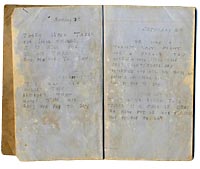
Lesson 3
Journals
- Time Required: several class sessions
- Curriculum Fits: History, Geography, Writing
Lesson Overview
People have kept journals for many reasons over the years. They provide a window into the past and are one of the ways we have learned about times passed. In this activity children will read from a journal of six year old Laura Jernegan, who lived in Edgartown and traveled to the Pacific with her family on a whaleship. Students will learn about important features of a journal and keep their own for a period of time. They will contrast and compare their experiences of today with Laura's life aboard ship in 1868 using a Venn diagram.
Learning Objectives
- Students will develop their ability to gather information through reading journals. First using the journal written by Laura Jernegan between the ages of 6 and 9, then using a journal kept by a classmate.
- Students will develop an understanding of the form and purpose of journal writing. Each entry includes the date and events of interest to the writer on that day.
- Students will become familiar with using a timeline, by adding events to a timeline of Laura's voyage as well as creating one of their own.
Materials
- primary source: pages from Laura Jernegan's journal, with transcriptions
- worksheet: Conversations with a Journal
- materials for student journals
- copy of timeline of Laura Jernegan's voyage
- Venn diagram worksheet
- worksheet: Compare and Contrast
Procedure
Part 1. Looking at journals
- Student teams read or listen to excerpts (1-2 pages) from Laura Jernegan's journal. Students share what they have learned about her life during this time on a class chart or on individual recording sheets ("Conversations with journals" worksheet).
- Student teams generate one or two questions based on what they've read.
Part 2. Creating journals
- Using a diary or journal format, students will keep a personal journal for approximately two weeks, recording events and observations of importance to them.
- Students will exchange a page or two of their journals with a partner. Using ONLY what is in the journal, students will repeat the process they used when looking at Laura's journal (stating on or two facts they learned and posing one or two questions).
Part 3. Comparing and contrasting a child's life
- Using a Venn diagram and/or a compare and contrast worksheet, students will compare and contrast the events and information they learned from Laura's journal with their own lives. This may be done as a whole class or in student teams.
Part 4. From journals to timelines
- The teacher will introduce the concept of a timeline, using Laura's as an example. Laura's timeline has personal events as well as world events during that time.
- Using the pages from Laura's journal, students add one event to her timeline.
- Students create personal timelines, which may be quite simple or more complex, depending on how much time the teacher wishes to spend. To give them practice in a simple way, students can enter four or five events from their personal journal on a timeline.
Authors
Martha Stackpole, Lauren Keaney-Serpa, Elaine Barnett, Kristy Fletcher